I've been working on this for a last couple months and it seems to be working well now. We planted 50 pines and I don't want to spend the summer hauling water to them. Since there is surface water available nearby, I decided to automate it.
I went with a slow flow rate because a higher flow rate would require everything be much bigger and much more expensive (pipe, pump, solar power, water source). But feeding drippers for hours doesn't take much, and soaks in better.
We built it incrementally testing each step as we went so we didn't end up with a large pile of parts that wouldn't work.
Step 1: I ran 600 feet of 1/2" irrigation tubing, with 1/4" tubing dropping down to each tree with a 1 gallon per hour dripper at each tree. We attached the 1/2" tubing to the top of the cages to keep it out of reach of the rodents.
Step 2: Before buying more, I connected pumps we had on hand to confirm the pipe and drippers can work with an adequate pump. The 1/5 hp submersible pump didn't supply enough head to water the highest trees. A 1" gas powered pump ran it fine, but it was choked back to around 1 gallon per minute.
Lessons learned:
- the 1/2" pipe can carry plenty of water for these drippers
- the pressure compensating drippers seem to compensate for the the pressure differnece from 15 feet of elevation change from one end to the other.
- the pump needs to be able to put out some pressure - a submerssible designed for minimal lift and and negligible pressure won't work.
Step 3: I bought a 12v diaphram pump and confirmed it is capable of supplying the needed pressure. I went with one rated for 3 gpm (at 0 head) or 40 PSI (at 0 flow). Choking it back to 1gpm restricts it enough that it builds enough pressure to work well. Before buying more, I connected it to the 12v output of my generator to make sure this pump is adeqate.
Step 4: I bought a solar panel, charge controller, timer, and battery. These are more than adequate for the pump, but I plan on using this power source for more stuff over time. At this point, I permanently mounted the pump (near the water source, on a board sheltered with a bucket), and set up the solar components in a steel tool box.
The pump claims its safe to run dry, and has a 4 year warranty. It has lots of reviews on Amazon, so I think that means I'll have a running pump for 4 years. If it fails before then, I'll exchange it. If it fails at 4 years and a day, I'll happily buy another.
The current problem we have is rodents chewing the drippers off to get water. I should have put the drippers at the top of the 1/4" tubing rather than the bottom, but we'll get them moved as they get chewed off. I'll also probably get some rodent repellent. Other than this, it's working well. The timer is set to run a few hours during the sunny part of the day. Both the charge controller and the battery's BMS have low voltage cutoff, so if it gets too cloudy it just won't run.
Parts list:
- panel
- charge controller (overkill for this, but I can add panels)
- battery (no longer listed on amazon, but its a 12AH LiFePO4 Weize battery with low temp protection for $70)
- timer
- pump
- 1/2 tubing
- 1/4 tubing and misc. connectors (it was cheaper when I got, and was the cheapest way to get 250' of 1/4' tubing at the time)
- drippers
- 1/4 connectors to tap the 1/2 line for 1/4" (should not have got these, should have used the drippers to tap the line)
- misc. wire, connectors, etc.
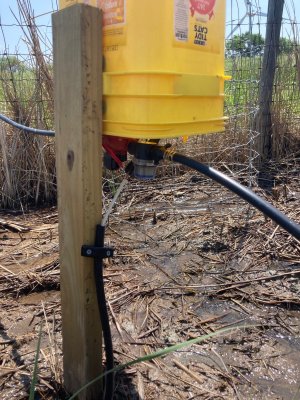

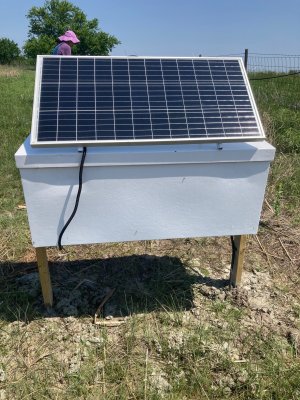
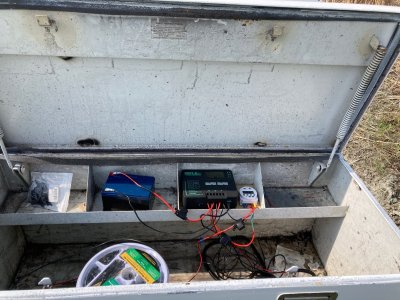
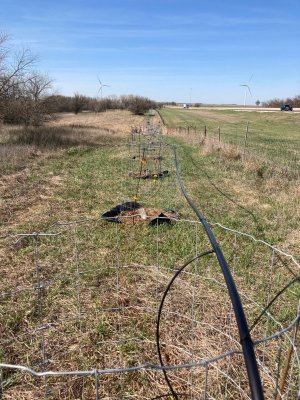
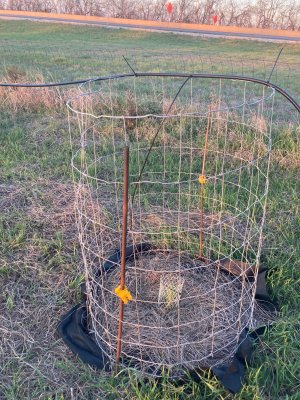
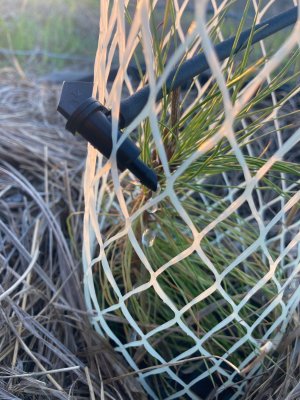
I went with a slow flow rate because a higher flow rate would require everything be much bigger and much more expensive (pipe, pump, solar power, water source). But feeding drippers for hours doesn't take much, and soaks in better.
We built it incrementally testing each step as we went so we didn't end up with a large pile of parts that wouldn't work.
Step 1: I ran 600 feet of 1/2" irrigation tubing, with 1/4" tubing dropping down to each tree with a 1 gallon per hour dripper at each tree. We attached the 1/2" tubing to the top of the cages to keep it out of reach of the rodents.
Step 2: Before buying more, I connected pumps we had on hand to confirm the pipe and drippers can work with an adequate pump. The 1/5 hp submersible pump didn't supply enough head to water the highest trees. A 1" gas powered pump ran it fine, but it was choked back to around 1 gallon per minute.
Lessons learned:
- the 1/2" pipe can carry plenty of water for these drippers
- the pressure compensating drippers seem to compensate for the the pressure differnece from 15 feet of elevation change from one end to the other.
- the pump needs to be able to put out some pressure - a submerssible designed for minimal lift and and negligible pressure won't work.
Step 3: I bought a 12v diaphram pump and confirmed it is capable of supplying the needed pressure. I went with one rated for 3 gpm (at 0 head) or 40 PSI (at 0 flow). Choking it back to 1gpm restricts it enough that it builds enough pressure to work well. Before buying more, I connected it to the 12v output of my generator to make sure this pump is adeqate.
Step 4: I bought a solar panel, charge controller, timer, and battery. These are more than adequate for the pump, but I plan on using this power source for more stuff over time. At this point, I permanently mounted the pump (near the water source, on a board sheltered with a bucket), and set up the solar components in a steel tool box.
The pump claims its safe to run dry, and has a 4 year warranty. It has lots of reviews on Amazon, so I think that means I'll have a running pump for 4 years. If it fails before then, I'll exchange it. If it fails at 4 years and a day, I'll happily buy another.
The current problem we have is rodents chewing the drippers off to get water. I should have put the drippers at the top of the 1/4" tubing rather than the bottom, but we'll get them moved as they get chewed off. I'll also probably get some rodent repellent. Other than this, it's working well. The timer is set to run a few hours during the sunny part of the day. Both the charge controller and the battery's BMS have low voltage cutoff, so if it gets too cloudy it just won't run.
Parts list:
- panel
- charge controller (overkill for this, but I can add panels)
- battery (no longer listed on amazon, but its a 12AH LiFePO4 Weize battery with low temp protection for $70)
- timer
- pump
- 1/2 tubing
- 1/4 tubing and misc. connectors (it was cheaper when I got, and was the cheapest way to get 250' of 1/4' tubing at the time)
- drippers
- 1/4 connectors to tap the 1/2 line for 1/4" (should not have got these, should have used the drippers to tap the line)
- misc. wire, connectors, etc.







Last edited:

